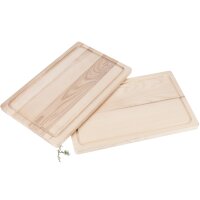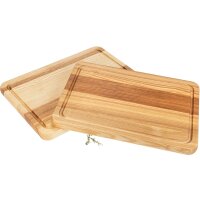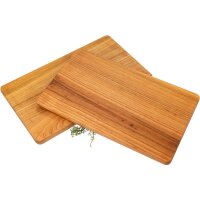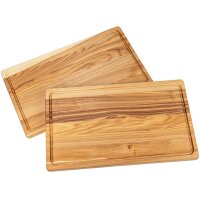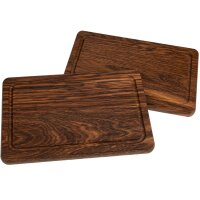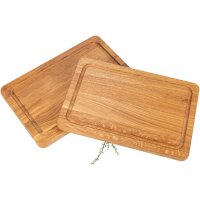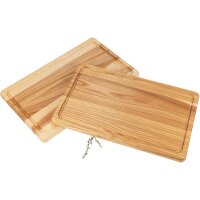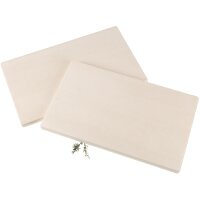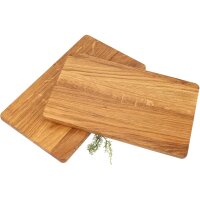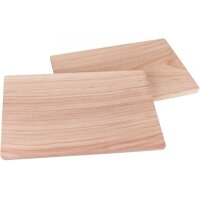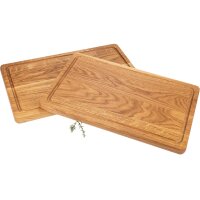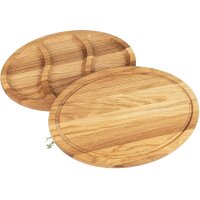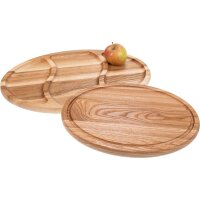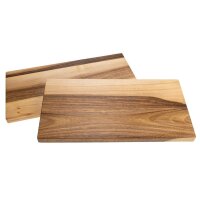Wooden Cutting Boards Guide – Selection, Care, Hygiene & Sustainability
This comprehensive guide covers everything you need to know about wooden cutting boards: from choosing the right material (maple, beech, oak, cherry, walnut, ash & bamboo) and proper care to hygiene best practices, end grain vs. edge/face grain, and a practical wood vs. plastic comparison. With insights from Holz Frank, you’ll make confident choices and get the most from your board—durable, knife-friendly, and sustainable.
Why choose a wooden cutting board?
- Knife-friendly: Wood fibres yield slightly, helping blades stay sharper for longer.
- Robust & durable: With proper care, quality boards last for many years.
- Hygienic in practice: Wood surfaces regulate moisture; with correct cleaning, kitchen hygiene is easy to maintain.
- Warm look & feel: Every board is unique with its own grain and character.
- Sustainable: Responsibly sourced timbers (e.g., FSC®) help conserve resources.
Wood species at a glance
Different woods suit different uses, aesthetics, and care routines:
| Wood | Characteristics | Recommendation |
|---|---|---|
| Maple | Fine-pored, light, fairly hard, smooth surface | All-rounder; great for veg, fruit, bread |
| Beech | Hard, even texture, classic workhorse | Daily use, strong value for money |
| Oak | Very robust, striking grain | Heavy chopping, decorative serving |
| Cherry | Medium-hard, warm reddish tone, elegant | Design accents, serving boards |
| Walnut | Dark, medium-hard, premium look | High-end aesthetic, knife presentation |
| Ash | Springy, pronounced growth rings | Rustic look, tough everyday work |
| Bamboo | Grass composite, generally very hard | Low maintenance, may be firm for ultra-fine edges |
Tip: For maximum cut resistance and stability, end-grain boards are a favourite. Upright fibres behave like a brush: cuts are visually less apparent and the surface stays attractive for longer.
End grain vs. edge/face grain
- End grain: Extremely cut-resistant, signature “checkerboard” look, typically heavier; ideal for heavy daily prep.
- Edge/face grain: Lighter, usually more affordable, versatile—perfect as an everyday chopping and serving board.
Cleaning & care – keep it hygienic and beautiful
After each use
- Scrape off residues with a spatula.
- Hand-wash with warm water and a little mild detergent—never put in the dishwasher.
- Dry immediately and let it air-dry upright so both sides can breathe.
Odours & stains
Sprinkle coarse salt, add lemon juice, scrub with the lemon half, let sit briefly, rinse with water, then dry.
Regular oiling
- Frequency: At first 1–2× per week; later every 3–6 weeks depending on use.
- Oil: Food-safe board oil (e.g., high-quality mineral oil or hard-drying natural oils). Apply thinly, allow to soak in, wipe off excess.
- Goal: Improved moisture resistance, pleasant feel, reduced staining.
Avoid
- Soaking, dishwashers, microwaves, ovens, or direct radiator heat.
- Prolonged moisture or drying on one side only (may encourage warping).
Wood vs. plastic – which suits you best?
- Wood: Natural, knife-friendly, premium feel; requires hand-washing and occasional oiling.
- Plastic: Dishwasher-safe; can be harder to fully clean once deep grooves develop, but is low-maintenance.
Pro tip: Use separate boards for different food groups (e.g., meat/fish, bread/veg) to prevent cross-contamination—whatever the material.
Sustainability & quality
Our boards come from responsibly managed European forests. FSC®-certified timbers support resource conservation and transparent supply chains—durable products you can feel good about.
FAQ – wooden cutting boards
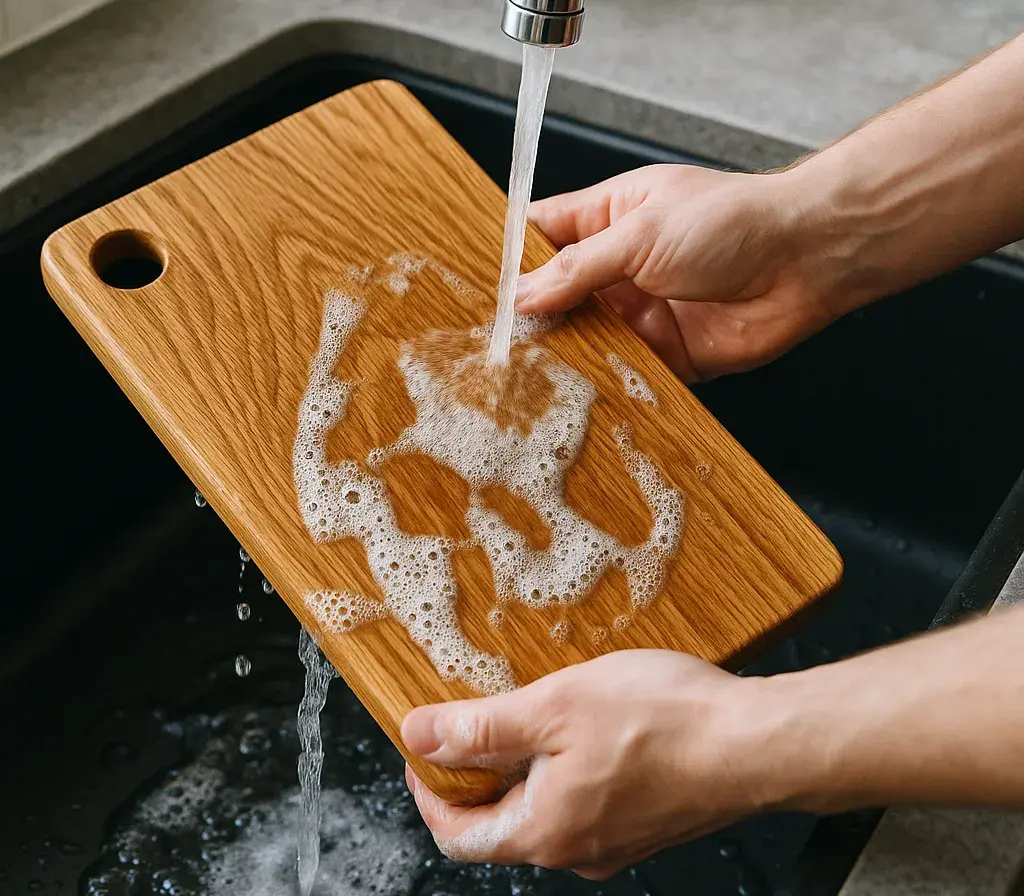
Care instructions for wooden cutting boards
Why is oiling cutting boards so important?
Frequent use and cleaning with water can dry out the wood fibers and make them brittle. The board can warp and even break. An oiled surface is resistant to dirt, moisture, and bacteria, keeping the board hygienic and preventing odors. Regular oiling keeps the board shiny and functional.Which oil is suitable for oiling cutting boards?
Use food-safe, tasteless oils:• Sunflower oil or rapeseed oil: Ideal because they are odorless and tasteless. Olive oil: Less suitable because it doesn't dry completely and can smell rancid.
Cleaning the cutting board
2. After intensive use (e.g., cutting meat): Clean thoroughly with mild detergent and a brush under hot water.
3. Drying: Allow to dry thoroughly while standing. Never soak or clean in the dishwasher.
Oiling Cutting Boards - Simple Instructions
2. Applying Oil: Apply oil (e.g., sunflower or rapeseed oil) evenly using a clean, soft cloth or kitchen paper. Use generously.
3. Allow to soak in: Leave to soak in for approximately 20 minutes.
4. Remove excess oil: Remove excess oil with a cloth and rub the surface again.
5. Allow to dry: Depending on the oil, approximately 24 hours.
Maintenance interval
Removing unpleasant odors For bad odors or stains:
2. Rub in: Rub the cutting board thoroughly with the mixture.
3. Allow to soak: Leave to soak for approximately 10 minutes.
4. Rinse and dry: Rinse under running water and allow to dry completely.
5. Re-oil: After this intensive cleaning, oil the board thoroughly again.
Buy high-quality cutting boards
How often should I oil my wooden cutting board?
The frequency with which a wooden cutting board should be oiled depends on several factors, such as frequency of use, environmental conditions, and the type of wood. As a rule of thumb:
- For regular use: Oil your cutting board about once a month.
- For occasional use: Oiling every two to three months may be sufficient.
- Consider the appearance: If the wood appears dry or dull, it's time for re-treatment.
It's important to use a food-grade oil, such as linseed oil, walnut oil, or sunflower oil. Apply the oil evenly and let it work for a few hours before removing any excess. This regular care helps protect the wood from moisture, preserve its natural beauty, and extend the life of your cutting board.
Why does my cutting board become rough after washing?
It can be frustrating when your new or freshly sanded cutting board becomes rough after washing. This phenomenon has several causes.
Wood type
The type of wood determines its sensitivity to moisture. For example, oak and ash are more likely to absorb moisture and become rough than other wood types.
Moisture
Fine wood fibers can stand up when in contact with water, causing the rough feeling on the surface.
Remedy
To reduce the roughness, you can treat the board with a metal sponge or sandpaper. Once the fine wood fibers are removed, they usually don't reappear.
Drying
It's important that your cutting board is thoroughly dried after rinsing. Ideally, you should store it upright or in a well-ventilated area to promote drying.
With proper care and by following these tips, you can effectively minimize the roughness of your cutting board and maintain its long-term condition.
Why a wooden cutting board and not plastic?
What type of wood should I use for a cutting board?
When choosing a European wood for cutting boards, hardness, hygiene, and environmental friendliness are important factors. Some of the best European woods for cutting boards are:
- Maple: European maple is hard and has a fine, even grain, making it an excellent choice for cutting boards. It is also gentle on knife blades.
- Beech: Beechwood is widely available and offers good hardness and density. It is robust and has a uniform grain that makes it difficult for bacteria to penetrate.
- Oak: Oak wood is not only hard and durable, but also has natural antibacterial properties, making it a safe choice for kitchen utensils.
- Ash: Ash wood is known for its robustness and elasticity, making it a good choice for cutting boards that are meant to withstand heavy use.
It is important that the wood comes from sustainable forestry to minimize its ecological footprint. Proper care and maintenance, such as regular oiling, will extend the lifespan of the cutting board, regardless of the type of wood chosen.
Is wood or bamboo better for a cutting board?
But is bamboo really as green as it seems? And are bamboo kitchen utensils truly healthy? At Holz Frank, we decided to answer precisely these questions and explain why we consciously chose domestic solid wood as the raw material for our products.
Although bamboo is considered a renewable resource due to its rapid growth, there are still some aspects that tarnish its ecological footprint. One of these is the long transport route that bamboo often has to travel from Asia to Europe, which leads to considerable CO2 emissions. In addition, the production of bamboo products often requires the use of harmful adhesives to join the bamboo fibers.
In contrast, Holz Frank relies on domestic solid wood that is sourced locally and sustainably. Our products have short transport routes and are sourced from sustainable forestry, not only contributing to environmental protection but also being free of harmful substances. While bamboo is often treated with toxic adhesives, we use only natural, non-toxic oils and glues in the manufacture of our wood products.
In addition to being environmentally and health-friendly, our European cutting boards impress with their high quality and durability. They are robust and heat-resistant and, with proper care, can be used for many years. This contributes to resource efficiency and underscores our commitment to sustainable production and consumption.
At Holz Frank, we are convinced of the superiority of solid wood products over bamboo. It is a choice that is not only environmentally conscious, but also high-quality and durable. We invite you to try our products and experience the difference for yourself. With Holz Frank, you are consciously choosing sustainability, quality, and health compatibility.
Why an end-grain cutting board?
End-grain cutting boards are popular with professional and home cooks alike and offer several advantages that make them an excellent choice for any kitchen:
- Kindness to knife blades: The end-grain structure of end-grain wood is gentler on knife blades. The wood fibers give under the pressure of the knife, helping the blade stay sharp longer.
- Self-healing properties: The unique structure of end-grain wood allows it to heal small cuts and nicks on its own. This contributes to the board's longevity and keeps it looking good for longer.
- Hygienic Benefits: Due to its dense structure, end grain offers natural resistance to bacteria and mold, making it a more hygienic option.
- Aesthetics: Last but not least, end grain cutting boards are also visually appealing. The grain and natural appearance of end grain make each board a unique work of art in your kitchen.
While end grain cutting boards are often more expensive to purchase, they offer a cost-effective investment in the long run due to their durability and the protection they provide for your kitchen knives.
Is oak a good wood for cutting boards?
Oak is a popular material for cutting boards, but with certain advantages and disadvantages:
Advantages of oak
- Durability: Oak is a very hard and robust wood, making it durable and resistant to cuts and scratches.
- Aesthetics: Oak has an attractive grain that gives cutting boards an appealing, natural appearance.
- Antibacterial properties: Oak has natural antibacterial properties due to its natural tannin, making it more hygienic than many other wood species. makes.
Disadvantages of oak wood
- Tannic acid: Oak wood is well-suited as a cutting board, but food should not be left on the cutting board for extended periods. The tannic acid can give the food a bitter taste.
- Moisture absorption: Oak wood has an open pore structure, which can tend to absorb more moisture and thus bacteria. Regular oiling and drying is therefore especially important.
- Weight: Due to its density, an oak cutting board can be heavier, which can make handling and storage difficult.
In summary, oak is a great choice for cutting boards due to its hardness, durability, and aesthetic qualities, but requires careful maintenance to retain its best qualities.
